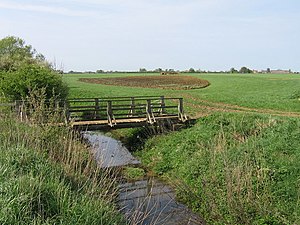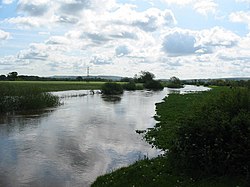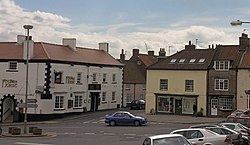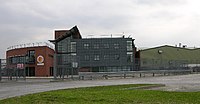Vale of Pickering
The Vale of Pickering is a broad, low-lying area in the eastern part of the North Riding of Yorkshire, drained by the River Derwent. The landscape is rural with scattered villages and small market towns. The present economy is largely agricultural with light industry and tourism playing an increasing role.
Contents
Location and transport
The Vale of Pickering is a low-lying plain, orientated in an east–west direction. It has been inhabited continuously from the Mesolithic age: the remarkable archaeological discoveries made at Star Carr in the vale include the oldest wooden structure found in Britain and much else besides.
The Vale is well defined by the Yorkshire Wolds escarpment to the south, the Corallian limestone foothills of the North York Moors to the north, the North Sea coast to the east and the Howardian Hills to the west.
The main roads running through the vale run east–west, the A64 and A170, following the shoreline of what was in ancient time a huge glacial lake, which formed in the vale after the last Ice Age. The main A69 road crosses the vale in a north–south direction, joining two little market towns: Malton and Pickering. At the eastern edge of the vale the A165 carries traffic along a north–south coastal route through Scarborough.
The main line railway crosses the eastern part of the vale from south to north west linking Malton to Scarborough and the east coast rail line links Scarborough to Filey, and Bridlington. A heritage railway, the North Yorkshire Moors Railway, runs from Pickering to Grosmont with connections to Whitby. It operates steam and old diesel engines in the tourist seasons.
Physical geography
Geology
The site of the post glacial Lake Pickering, the vale has a predominantly level topography covered by glacial drift deposits, with some rolling low ground on boulder clay and moraines in the far east. The underlying Jurassic sandstones and mudstones have little direct influence upon the landscape. There are minor outliers of Jurassic limestone in places at the foot of the Howardian Hills and the North York Moors, and there is some eroded chalk from the Wolds mixed with sands at the base of the Wolds in the southeast. There are springs associated with calcareous aquifers in places on the periphery of the vale.
Drainage
The Vale of Pickering is a drainage basin for the surrounding hills. At the eastern end of the area the canalised and straightened River Hertford drains west into the Derwent, which rises on the North York Moors a few miles from Scarborough before draining southwards into the vale. At the western part of the area the River Rye and its numerous tributaries flow eastwards and join the Derwent to the north of Malton. The Derwent then flows southwards through Malton and the Kirkham gorge to eventually join the River Ouse at Barmby on the Marsh.
Many of the watercourses in the Vale are maintained by the three Vale of Pickering internal drainage boards.
Natural history
Following the last Ice Age, Lake Pickering gradually drained away leaving a complex of rivers and marshes. The carrs, marshes, ings and wet meadows have now all been drained by humans and, as well as the rivers, the landscape is crossed by a network of canalised drainage ditches and canals which regulate the water table. In spite of this legacy of river engineering and land drainage the rivers of the Vale of Pickering remain one of the most important wildlife features of the area. There are many species of aquatic birds, plants insects and mammals inhabiting the edges of the becks and rivers and greyling and brown trout fish thrive in the rivers of the western area. The deep-sided drains that are managed by frequent dredging and contaminated by agricultural run off are poor habitats for wildlife.
Drainage has created reasonably fertile soils, which are used for arable cultivation and for pasture. There are flat open pastures, areas of intensive arable production and more varied undulating, enclosed landscapes which creates diversity within the vale as a whole. Woodland is sparse but there is more in the east towards West Ayton and Wykeham.
The coastal belt has a rather different landscape. The land to the east was not part of glacial Lake Pickering and glacial deposits have created a more hilly undulating landscape. In all areas agricultural development has resulted in a loss of natural habitats except for small relics of former areas which are now being monitored and conserved.[1]
History and settlement
The earliest known evidence of human presence in the area dates back to the Mesolithic period, around 7000 BC. The most important remaining settlement of this period is that at Star Carr[2] near Scarborough, where, due to waterlogged conditions, a considerable quantity of organic remains as well as flint tools, have survived. This is Britain’s best-known Mesolithic site. The site, on the eastern shores of glacial 'Lake Pickering', was surrounded by birch trees, some of which had been cleared and used to construct a rough platform of branches and brushwood. Lumps of turf and stones had been thrown on top of this construction to make a village site. The site was probably visited from time to time by about four or five families who were engaged in hunting, fishing and gathering wild plants as well as manufacturing tools and weapons and working skins for clothes.[3] On the southern edge of the vale lies West Heslerton, where recent excavation has revealed continuous habitation since the Late Mesolithic Age, about 5000 BC. This site has revealed a great deal of dwelling and occupation evidence from the Neolithic period to the present day.[4]
The development of farming during the succeeding Neolithic period is evident in the distribution of earth long barrows throughout the area. Bronze and Iron Age remains have been found on the fringe of the vale. There are sections of Roman roads and Roman villas, which indicate economic activity in the vale at the time.
The vale is rich in the remains of the English mediæval period, between the 11th and 15th centuries. There are castles, such as those at Helmsley and Pickering,[5] as well as fortified manor houses and churches of the period. There is also a notable example of mediæval strip fields at Middleton.
In the 17th and 18th centuries wealthy landowners created fine buildings and estates such as those at Wykeham Abbey, Nunnington Hall and Ebberston Hall.
The village sof the vale follow the differening shapes of the land. The villages and towns on the northern and southern fringes of the area sit close to each other, interestingly standing by the approximate shoreline of the glacial lake which disappeared millennia before the villages appeared: this is the spring line, where the underlying aquifers met less porous rocks. Many of the parishes associated with the settlements are linear running from the vale bottom upwards to the higher ground, meaning that the long narrow parishes each had an amount of different types of soil and elevation. The second type of settlement is on the valley floor. These are small more widely spaced villages in areas of rising ground. These villages result from the relatively late enclosure of the carr lands following their drainage at the beginning of the 19th century. Long narrow lanes and tracks with wide grass verges link these settlements and solid well managed hedges.
Building materials vary from soft limestones and sandstones to harder gritstones. The steep slopes of the roofs suggests that the older buildings had thatch coverings but these have been mostly replaced by red pantiles.[6]
Economy
The market towns of Helmsley, Kirkbymoorside, Pickering and Malton are the largest centres of population in the inland parts of the Vale. The eastern part of the area is dominated by the influence of Scarborough.
The largest employer in the district is the Malton Bacon Factory, employing more than 2,000 people. Other businesses generally employ less than 25 people.[7]
The main source of employment in the vale is agriculture with tourism and retailing in the market towns and near to the coast.
Places of interest
- Ruins of Helmsley Castle
- Nunnington Hall, 17th century manor House with a sheltered walled garden on the banks of the River Rye.
- Pickering Castle, a classic and well-preserved example of an early castle.
- Filey
- Flamingoland
- Malton, the largest of the market towns in the vale
Outside links
- Location map: 54.2 -0.7
References
- ↑ "The Vale of Pickering Natural Area Profile" (PDF). English Nature. http://www.english-nature.org.uk/science/natural/profiles/naProfile18.pdf. Retrieved 2008-05-03.
- ↑ Dr Nicky, Milner (2006-11-13). "Star Carr. Excavation in the Valof Pickering". York University. http://www.york.ac.uk/depts/arch/Projects/StarCarrWebsite/index.htm. Retrieved 2010-06-20.
- ↑ Dyer, James (2002-02-06). Ancient Britain. London: Routledge. ISBN 0-415-15151-1. OCLC 38948627.
- ↑ Powlesland, Dominic. 25 years of archaeological research on the sands and gravels of Heslerton. The Landscape Research Centre Ltd. http://www.landscaperesearchcentre.org/AA%20Tier%201%20Primary%20Headings/Publications.htm.
- ↑ "North Yorkshire". English Heritage. 2008. http://www.english-heritage.org.uk/server/show/nav.17021. Retrieved 2008-05-03.
- ↑ "Valeof Pickering" (PDF). Natural England. http://www.countryside.gov.uk/Images/JCA26_tcm2-21131.pdf. Retrieved 2008-05-03.
- ↑ "The Ryedale Local Plan". Ryedale District Council. 2002-03-22. http://www.imagine-ryedale.org.uk/localplan/indexwrittenstatement.htm. Retrieved 2008-05-03.



